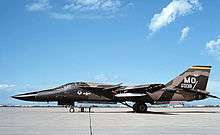388th Electronic Combat Squadron
| 388th Electronic Combat Squadron | |
|---|---|
|
Emblem of the 388th Electronic Combat Squadron | |
| Active | 1942–1959, 1971-1979, 1981-1982, 2004-2010 |
| Country | United States |
| Branch | United States Air Force |





The 388th Electronic Combat Squadron is an inactive United States Air Force unit. Its last assignment was with the 366th Fighter Wing, based at Naval Air Station Whidbey Island, Washington as a Geographically Separated Unit (GSU).
History
Established in early 1942 as a light bomb squadron, equipped with A-24 Banshees, although equipped with export model A-31 Vengeance dive bombers for training. Trained under Third Air Force in the southeast United States, also used for antisubmarine patrols over the Atlantic southeast coast and then Gulf of Mexico.
Deployed to Southern California in early 1943 to the Desert Warfare Center, trained in light bombing while supporting Army maneuvers in the Mojave Desert until October.
Re-equipped with North American A-36 Apache dive bombers and deployed to New Guinea as part of Fifth Air Force. In the Southwest Pacific the squadron attacked Japanese strong points and tactical positions and targets of opportunity in support of MacArthur's campaign along the north coast of New Guinea; then advancing into the Netherlands East Indies and Philippines as part of the Island Hopping campaign. Re-equipped with P-40s; then later A-20 Havocs. Engaged in heavy fighting on Lete; Mindoro and Luzon in the Philippines during 1944-1945.
The squadron moved to Okinawa in mid-August and after the Atomic Bomb missions had been flown; remained on Okinawa until December until returning to the United States with most personnel demobilizing. It was inactivated as a paper unit on January 6, 1946.
The squadron was reactivated as a B-29 Superfortress unit in the reserves in 1947, but lack of funding and personnel led to rapid inactivation.
Transferred to Tactical Air Command in the mid-1950s and activated first with F-68 Sabres, then F-100 Super Sabres in 1958. Inactivated in 1959 when its parent 312th TFW was inactivated and re-designated as the 27th TFW. Personnel and equipment of the squadron were re-designated as the 524th Tactical Fighter Squadron.
Reactivated in 1977 as an F-111A training squadron; inactivated 1979. Reactivated in 1981 as an EF-111A Raven electronic warfare aircraft; inactivated 1982. Reactivated in 2004 flying Naval EA-6B prowler electronic warfare aircraft. It inactivated in 2010, replaced by the 390th Electronic Combat Squadron.
Lineage
- Constituted 388th Bombardment Squadron (Light) on January 28, 1942
- Activated on March 15, 1942
- Redesignated: 388th Bombardment Squadron (Dive) on July 27, 1942
- Redesignated: 388th Bombardment Squadron (Light) on December 6, 1943
- Redesignated: 388th Bombardment Squadron (Heavy) on July 19, 1945
- Inactivated on December 18, 1945
- Redesignated: 388th Bombardment Squadron (Very Heavy) on July 14, 1947
- Activated in the reserve on July 30, 1947
- Inactivated on June 27, 1949
- Redesignated: 388th Fighter-Bomber Squadron on July 29, 1954
- Activated on October 1, 1954
- Redesignated: 388th Tactical Fighter Squadron on July 1, 1958
- Inactivated on February 18, 1959.
- Redesignated: 388th Tactical Fighter Training Squadron on 7 February 1977.
- Activated on 1 July 1977.
- Inactivated on 30 September 1979.
- Redesignated 388th Electronic Combat Squadron on 29 January 1981.
- Activated on 1 July 1981.
- Inactivated on 15 December 1982.
- Activated on 15 December 2004.
- Inactivated on 27 September 2010.
Assignments
- 312th Bombardment Group, March 15, 1942 – December 18, 1945
- Tenth Air Force, July 30, 1947
- 312th Bombardment Group, August 13, 1947 – June 27, 1949
- 312th Fighter-Bomber Group, October 1954
- 312th Fighter-Bomber (later Tactical Fighter) Wing, October 8, 1957 – February 18, 1959.
- Attached to Air Task Force 13 [Provisional], 4 September-3 December 1958
- 366th Tactical Fighter Wing, 1 July 1977 – 30 September 1979; 1 July 1981 – 15 December 1982
- 366th Operations Group, 15 December 2004–present
Stations
Aircraft
- A-31 Vengeance, 1942–1943
- A-24 Banshee, 1942–1943
- North American A-36, 1943
- P-40 Warhawk, 1943–1944
- A-20 Havoc, 1944–1945
- F-86 Sabre, 1955–1956
- F-100 Super Sabre, 1956–1959.
- F-111A Aardvark, 1977-1979.
- EF-111A Raven, 1981-1982.
- EA-6B Prowler, 2004–present
References
![]() This article incorporates public domain material from the Air Force Historical Research Agency website http://www.afhra.af.mil/.
This article incorporates public domain material from the Air Force Historical Research Agency website http://www.afhra.af.mil/.
- Maurer, Maurer, ed. (1983) [1961]. Air Force Combat Units of World War II (PDF) (reprint ed.). Washington, DC: Office of Air Force History. ISBN 0-912799-02-1. LCCN 61060979.
- Maurer, Maurer, ed. (1982) [1969]. Combat Squadrons of the Air Force, World War II (PDF) (reprint ed.). Washington, DC: Office of Air Force History. ISBN 0-405-12194-6. LCCN 70605402. OCLC 72556.

.svg.png)